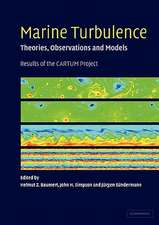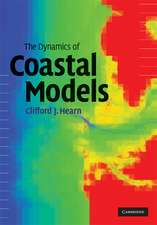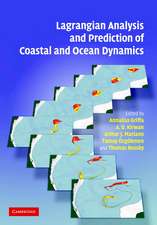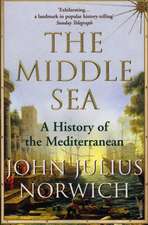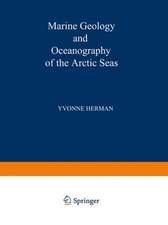The Organic Carbon Cycle in the Arctic Ocean
Editat de Rüdiger Stein, Robie W. Macdonalden Limba Engleză Paperback – 2 oct 2013
| Toate formatele și edițiile | Preț | Express |
|---|---|---|
| Paperback (1) | 805.67 lei 38-44 zile | |
| Springer Berlin, Heidelberg – 2 oct 2013 | 805.67 lei 38-44 zile | |
| Hardback (1) | 829.17 lei 38-44 zile | |
| Springer Berlin, Heidelberg – 21 sep 2003 | 829.17 lei 38-44 zile |
Preț: 805.67 lei
Preț vechi: 1060.09 lei
-24% Nou
Puncte Express: 1209
Preț estimativ în valută:
154.16€ • 160.96$ • 127.59£
154.16€ • 160.96$ • 127.59£
Carte tipărită la comandă
Livrare economică 01-07 aprilie
Preluare comenzi: 021 569.72.76
Specificații
ISBN-13: 9783642623516
ISBN-10: 3642623514
Pagini: 384
Ilustrații: XIX, 363 p.
Dimensiuni: 193 x 270 x 20 mm
Greutate: 0 kg
Ediția:Softcover reprint of the original 1st ed. 2004
Editura: Springer Berlin, Heidelberg
Colecția Springer
Locul publicării:Berlin, Heidelberg, Germany
ISBN-10: 3642623514
Pagini: 384
Ilustrații: XIX, 363 p.
Dimensiuni: 193 x 270 x 20 mm
Greutate: 0 kg
Ediția:Softcover reprint of the original 1st ed. 2004
Editura: Springer Berlin, Heidelberg
Colecția Springer
Locul publicării:Berlin, Heidelberg, Germany
Public țintă
ResearchCuprins
1 The Arctic Ocean: Boundary Conditions and Background Information.- 1.1 Physiography and Bathymetry of the Arctic Ocean.- 1.1.1 Introduction.- 1.1.2 Definition of the Arctic Ocean and its Constituent Seas.- 1.1.3 Bathymetry and Physiography.- 1.1.4 Volumes, Areas and Mean Depths of the Arctic Ocean and its Constituent Seas.- 1.2 The Arctic Ocean: Modern Status and Recent Climate Change.- 1.2.1 Modern hydrography and Sea-ice Cover of the Arctic Ocean.- 1.2.2 The Arctic Ocean and Global Change.- 1.2.2.1 The distant past.- 1.2.2.2 Recent change and the Arctic Oscillation.- 1.2.2.3 The Future.- 1.3 The Tectonic Evolution of the Arctic Ocean: Overview and Perspectives.- 1.4 Geochemical Proxies Used for Organic Carbon Source Identification in Arctic Ocean Sediments.- 1.4.1 Introduction.- 1.4.2 Organic geochemical bulk parameters.- 1.4.3 Maceral composition.- 1.4.4 Biomarker composition.- 1.4.5 The application of redox markers to organic carbon sediment geochemistry.- 2 Modern Terrigenous Organic Carbon Input to the Arctic Ocean.- 2.1 General Introduction.- 2.2 River Input.- 2.2.1 Introduction.- 2.2.2 River water and suspended matter.- 2.2.3 Fluxes of organic carbon.- 2.3 Organic Carbon Input to the Artic Seas Through Coastal Erosion.- 2.3.1 Introduction.- 2.3.2 Methodology.- 2.3.3 Coastal organic carbon input.- 2.4 The Role of Arctic Sea Ice in Transporting and Cycling Terrestrial Organic Matter.- 2.4.1 Introduction.- 2.4.2 Methods.- 2.4.3 Sea ice transport in the Arctic Ocean and entrainment of particulate matter.- 2.4.4 Dissolved organic carbon in sea ice.- 2.4.5 Particulate organic carbon in sea ice.- 2.4.6 Conclusions.- 2.5 Aeolian Input.- 2.6 Summary and Concluding Remarks.- 3 Primary and Secondary Production in the Arctic Seas.- 3.1 Introduction.- 3.2 Major Algal Groups and Their Distribution.- 3.2.1 Distribution of species.- 3.2.2 Nutritional and chemical properties.- 3.3 Limitation and Control of Primary Production.- 3.3.1 Light.- 3.3.2 Nutrients.- 3.4 Primary Production and Growth Rate.- 3.4.1 New vs. regenerative primary production.- 3.4.2 Chla: C ratio, light saturation index, photoacclimation.- 3.4.3 Growth rate.- 3.4.4 Growth strategies.- 3.5 Seasonality.- 3.5.1 Pre-bloom, winter and survial.- 3.5.2 Spring blooms, vertical mixing and ice-edge blooms.- 3.5.3 The post bloom.- 3.6 Distribution of Primary Production.- 3.6.1 The deep Arctic Ocean Basin.- 3.6.2 Polynyas.- 3.6.3 Arctic Shelf Seas.- 3.6.4 The Atlantic sector: The Nordic Seas, Baffin Bay, Hudson Bay and Labrador Sea.- 3.6.5 Bering Shelf.- 3.6.6 Oceanic Bering Sea.- 3.6.7 Sea of Okhotsk.- 3.7 Mesozooplankton.- 3.7.1 Mesozooplankton biomass.- 3.7.2 Grazing and mesozooplankton production.- 3.7.3 Match-mismatch.- 3.8 Primary Production — Impact of Climate Change.- 3.9 Summary and Concluding Remarks.- 4 The Role of Dissolved Organic Matter for the Organic Carbon Cycle in the Arctic Ocean.- 4.1 Introduction.- 4.2 Riverine DOM on Arctic Shelves and Beyond.- 4.2.1 Estuarine Mixing.- 4.2.2 Chemical characteristics and origin of DOM on the Eurasian shelf.- 4.2.3 The role of bacteria and photochemical processes on the Eurasian shelf.- 4.2.4 The role of sea ice formation on DOM on the Eurasian shelf.- 4.2.5 The distribution of terrestrial DOM in the central Arctic Ocean and the GIN Sea.- 4.3 Distribution, Chemical Composition, and Fluxes of Marine DOM in the Central Arctic Ocean.- 4.3.1 Primary production and bacterial utilization of DOM.- 4.3.2 DOM distribution and chemical composition.- 4.3.3 DOC exchanges between the Arctic Ocean and adjacent Ocean basins.- 4.3.4 Vertical export of DOC in the Arctic Ocean.- 4.4 Summary and Concluding Remarks.- 5 Particulate Organic Carbon Flux to the Arctic Ocean Sea Floor.- 5.1 Introduction.- 5.2 What do we Know About Vertical Carbon Flux from the Arctic Ocean.- 5.3 Case Studies.- 5.3.1 North Water Polynya (B. Hargrave).- 5.3.2 North East Water Polynya (E. Bauerfeind).- 5.3.3 Greenland Sea (R. Peinert, T. Noji).- 5.3.4 Central Barents Sea and Northern Spitsbergen.- 5.3.5 Eastern Barents Sea and Kara Sea (V. Shevchenko).- 5.3.6 Laptev Sea and Lomonosov Ridge (E.-M. Nöthig, V. Shevchenko).- 5.3.7 Northern Bering Sea (H. Sasaki, M. Fukuchi).- 5.3.8 Canadian Ice Island (B. Hargrave).- 5.3.9 Canadian Archipelago: Barrow Strait (M. Fortier).- 5.4 Regional Variability in POC Export Flux in the Arctic Ocean Determined Using 234Th as a Tracer.- 5.4.1 Introduction and Background.- 5.4.2 Uncertainties in 234Th-derived POC Export Fluxes.- 5.4.3 Regional Variability in Arctic POC Export Fluxes.- 5.4.4 Conclusions.- 5.5 Particulate Organic Carbon Flux to the Seafloor of the Arctic Ocean: Quantity, Seasonality and Processes.- 5.5.1 Seasonal and Annual Estimates of Vertical Carbon Export.- 5.5.2 Ice, Light, Stratification, and Vertical Carbon Export.- 5.5.3 River Run-off, Resuspension, and Vertical Carbon Export.- 5.5.4 High Retention of Vertical Carbon Export in the Twilight Zone of the Arctic Ocean.- 5.5.5 Global Warming and Vertical Carbon Export.- 5.6 Summary and Concluding Remarks.- 6 The Benthos of Arctic Seas and its Role for the Organic Carbon Cycle at the Seafloor.- 6.1 Introduction.- 6.2 Origin and Evolution of Arctic Habitats and Species.- 6.3 Food Supply of the Arctic Benthos: Sources and Pathways.- 6.4 Benthic Communities of the Arctic Seas.- 6.4.1 Arctic Shelves and Margins.- 6.4.2 Central Arctic.- 6.5 Organic Carbon Utilization by the Arctic Benthos.- 6.5.1 Arctic Continental Shelves.- 6.5.2 Central Arctic Ocean.- 6.6 Summary and Concluding Remarks.- 7 Organic Carbon in Arctic Ocean Sediments: Sources, Variability, Burial, and Paleoenvironmental Significance.- 7.1 Organic Carbon in Arctic Ocean Sediments: A General Introduction.- 7.1.1 Pre-Quaternary (Jurassic-Cretaceous) Organic Carbon Records.- 7.1.2 Modern and Late Quaternary Organic Carbon Records.- 7.2 The Beaufort Sea: Distribution, Sources, Fluxes, and Burial Rates of Organic Carbon.- 7.2.1 Introduction.- 7.2.2 Data Base.- 7.2.3 Distribution and Sources of Organic Carbon in Surface Sediments.- 7.2.4 The Effect of Sea-level Rise During the Holocene.- 7.2.5 Burial Rates of Organic Carbon and Budget.- 7.2.6 Summary and Concluding Remarks.- 7.3 The Continental Margin of the North Bering-Chukchi Sea: Distribution, Sources, Fluxes, and Burial Rates of Organic Carbon.- 7.3.1 Introduction.- 7.3.2 Data Base, Material and Methods.- 7.3.3 Distribution and Sources of Organic Carbon in Surface Sediments.- 7.3.4 Fluxes, Accumulation, Burial Rates, and Remineralization of OC, and Benthic Oxygen Uptake Rates.- 7.3.5 Summary and Concluding Remarks.- 7.4 The East Siberian Sea: Distribution, Sources, and Burial of Organic Carbon.- 7.4.1 Introduction.- 7.4.2 Data base, Material and Methods.- 7.4.3 Distribution and Sources of Organic Carbon in Surface Sediments.- 7.4.4 Burial Rates of Organic Carbon.- 7.4.5 Summary and Concluding Remarks.- 7.5 The Laptev Sea: Distribution, Sources,Variability and Burial of Organic Carbon.- 7.5.1 Introduction.- 7.5.2 Data base, Material and Methods.- 7.5.3 Distribution and Sources of Organic Carbon in Surface Sediments.- 7.5.4 Late Quaternary Organic Carbon Records and Paleoenvironment.- 7.5.5 Accumulation Rates and Budget of Total Sediment and Organic Carbon.- 7.5.6 Summary and Concluding Remarks.- 7.6 The Kara Sea: Distribution, Sources,Variability and Burial of Organic Carbon.- 7.6.1 Introduction.- 7.6.2 Data base, Material and Methods.- 7.6.3 Distribution and Sources of Organic Carbon in Surface Sediments.- 7.6.4 Late Quaternary Organic Carbon Records and Paleoenvironment.- 7.6.5 Budget of Total Sediment and Organic Carbon.- 7.6.6 Summary and Concluding Remarks.- 7.7 The Barents Sea: Distribution, Sources,Variability and Burial of Organic Carbon.- 7.7.1 Introduction.- 7.7.2 Data base, Material and Methods.- 7.7.3 Distribution and Sources of Organic Carbon in Surface Sediments.- 7.7.4 Late Quaternary Organic Carbon Records and Paleoenvironment.- 7.7.5 Burial Rates and Organic Carbon Budget.- 7.7.6 Summary and Concluding Remarks.- 7.8 Northern Fram Strait und Yermak Plateau: Distribution,Variability and Burial of Organic Carbon and Paleoenvironmental Implications.- 7.8.1 Introduction.- 7.8.2 Data base, Material and Methods.- 7.8.3 Distribution and Sources of Organic Carbon in Surface Sediments.- 7.8.4 Late Quaternary Organic Carbon Records and Paleoenvironment.- 7.8.5 Accumulation Rates and Organic Carbon Budget.- 7.8.6 Summary and Concluding Remarks.- 7.9 The Central Arctic Ocean: Distribution, Sources, Variability and Burial of Organic Carbon.- 7.9.1 Introduction.- 7.9.2 Data base, Material and Methods.- 7.9.3 Distribution and Sources of Organic Carbon in Surface Sediments.- 7.9.4 Late Quaternary Organic Carbon Records and Paleoenvironment.- 7.9.5 Accumulation Rates and Budget of Total Sediment and Organic Carbon.- 7.9.6 Summary and Concluding Remarks.- 8 Organic Carbon Budget: Arctic Ocean vs. Global Ocean.- 8.1 Introduction.- 8.2 Global Organic Carbon Fluxes: Sources and Sinks.- 8.3 Arctic Ocean Organic Carbon Fluxes: Sources and Sinks.- 8.4 Summary and Concluding Remarks.- 9 References.
Recenzii
From the reviews:
"The book is an extraordinary compilation of interesting information and a succession of important interpretations about the production, delivery, degradation, and burial of organic matter in the world’s only polar ocean. … The three features of the book that make it particularly special are its content, its presentation, and its timeliness. … Because of the way that Stein and Macdonald have so effectively integrated and organized a wealth of information about the Arctic, many kinds of scientists would benefit from it." (Phillip A. Meyers, Polar Record, Vol. 41 (3), 2005)
"The book is an extraordinary compilation of interesting information and a succession of important interpretations about the production, delivery, degradation, and burial of organic matter in the world’s only polar ocean. … The three features of the book that make it particularly special are its content, its presentation, and its timeliness. … Because of the way that Stein and Macdonald have so effectively integrated and organized a wealth of information about the Arctic, many kinds of scientists would benefit from it." (Phillip A. Meyers, Polar Record, Vol. 41 (3), 2005)
Caracteristici
Comprehensive overview of organic-carbon sources written by both editors, who have extensive experience in oceanographic research in the Atlantic
Includes supplementary material: sn.pub/extras
Includes supplementary material: sn.pub/extras

